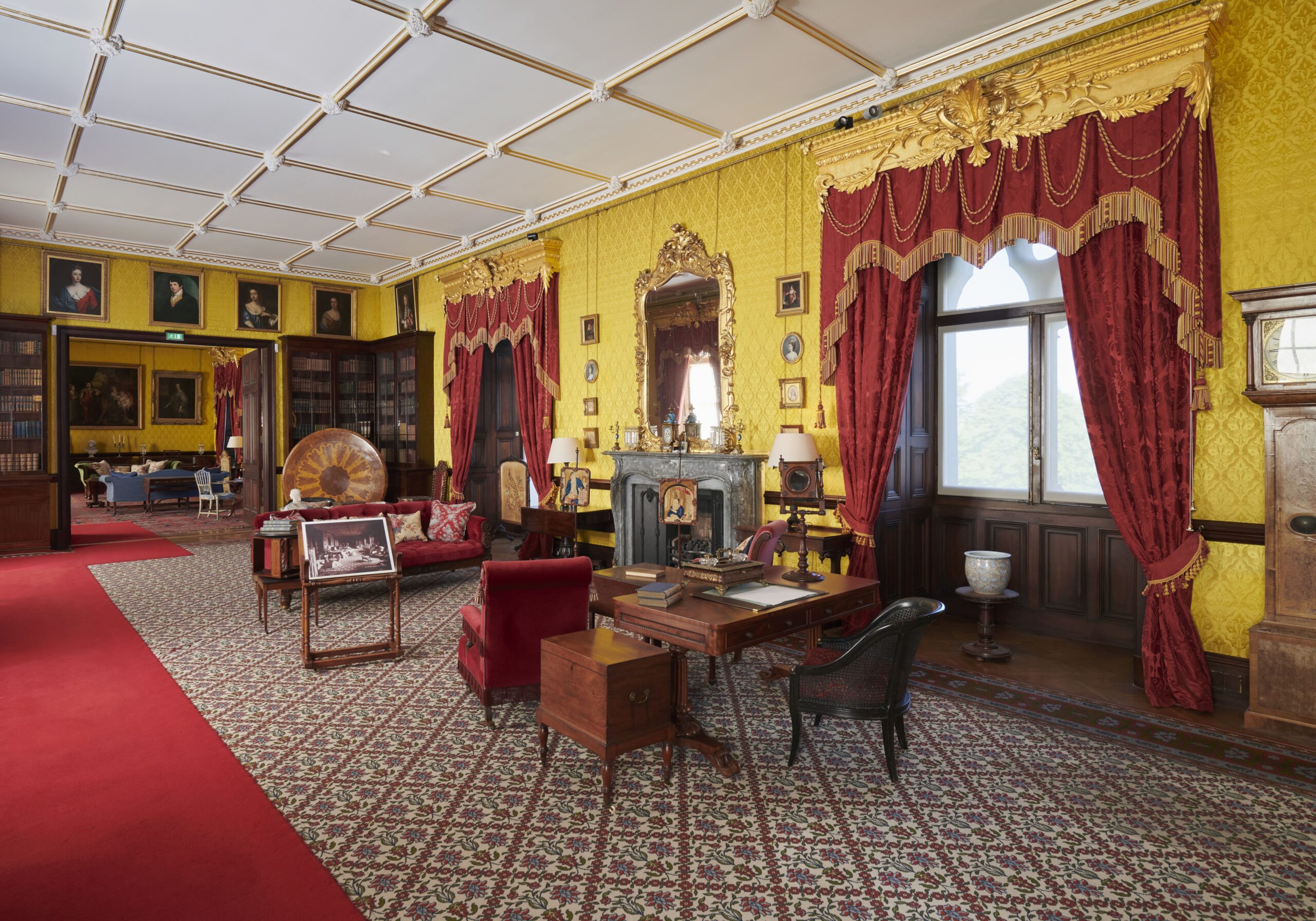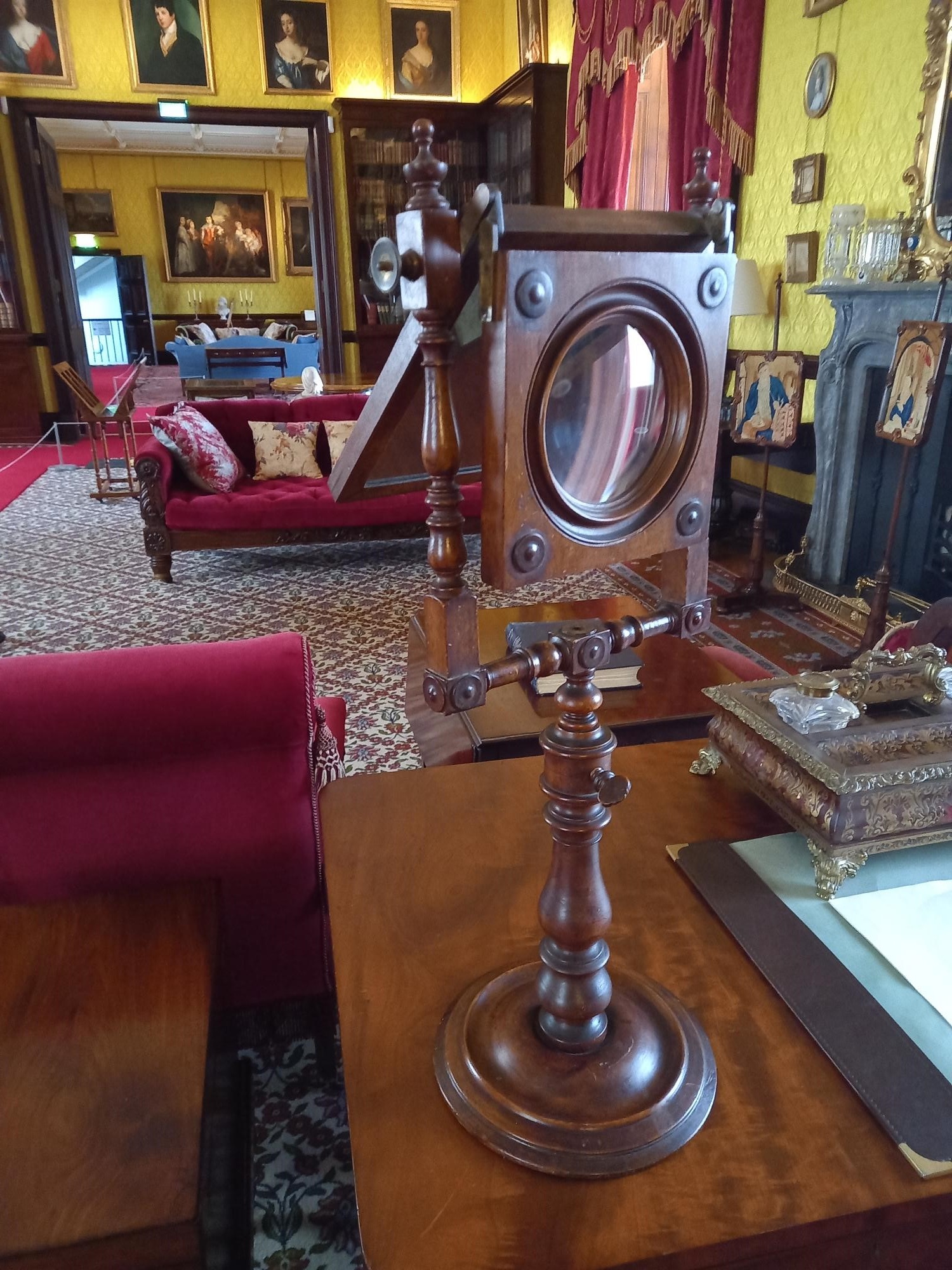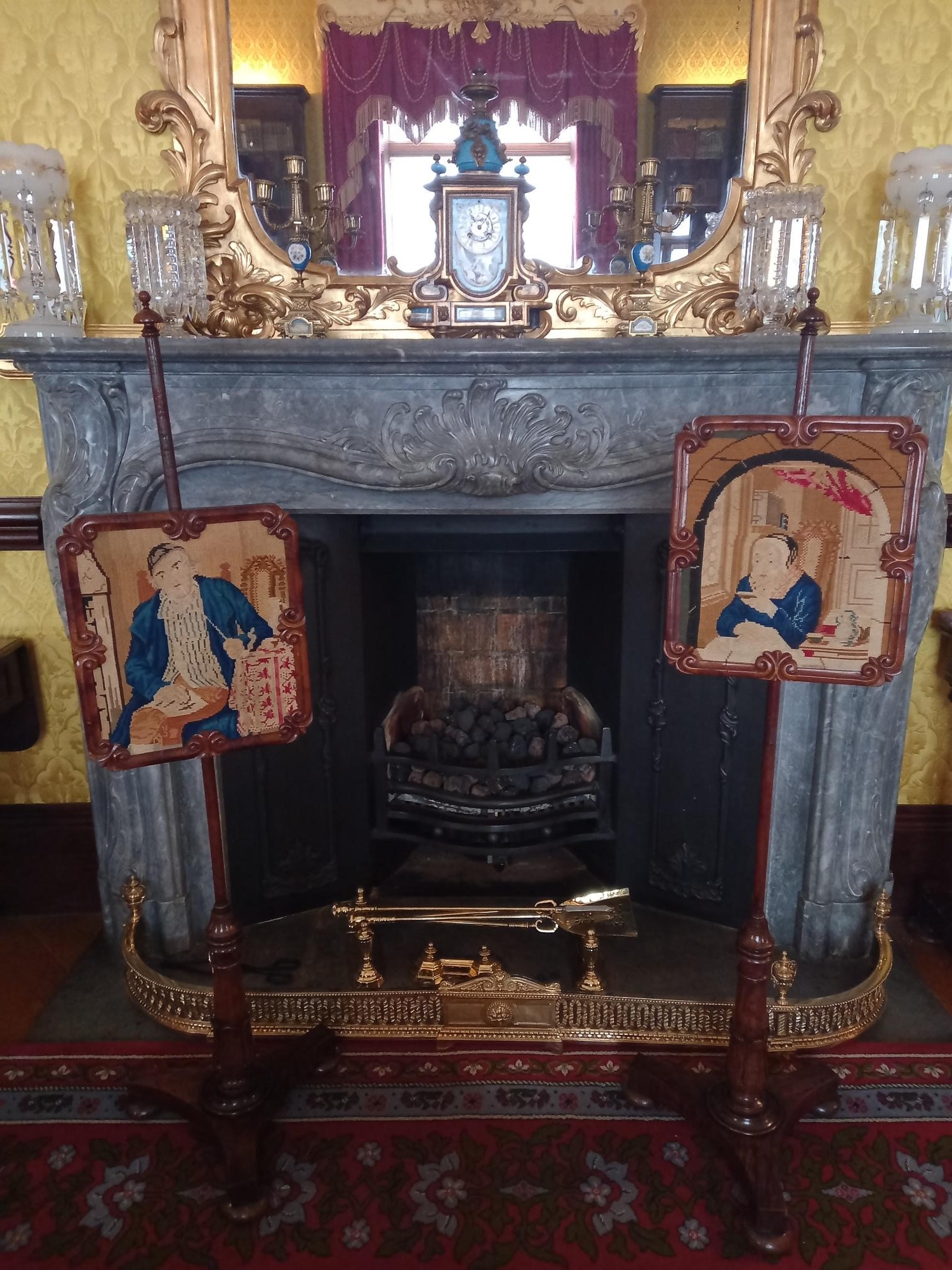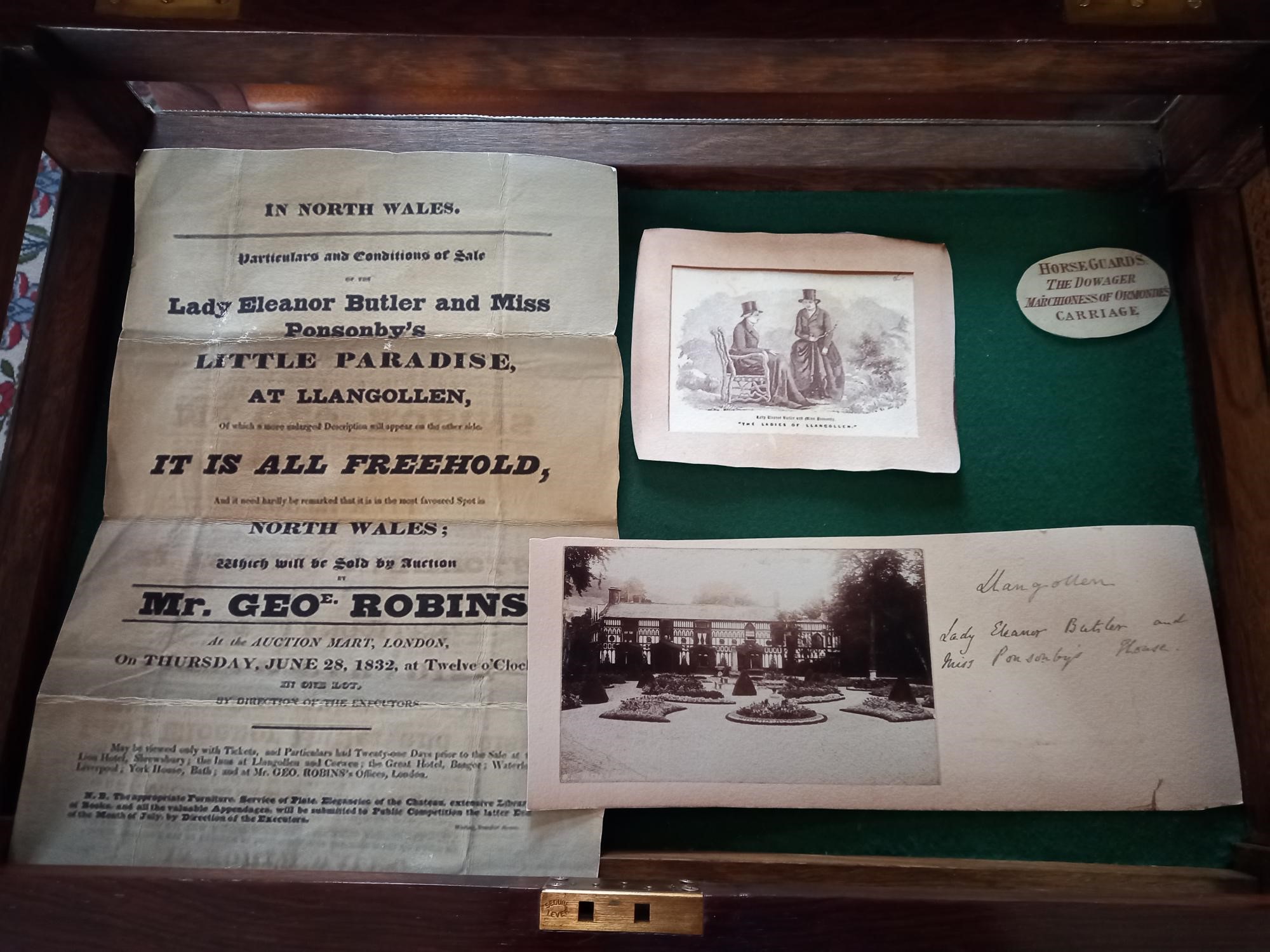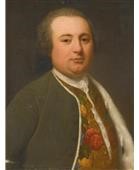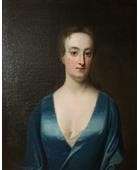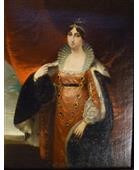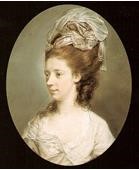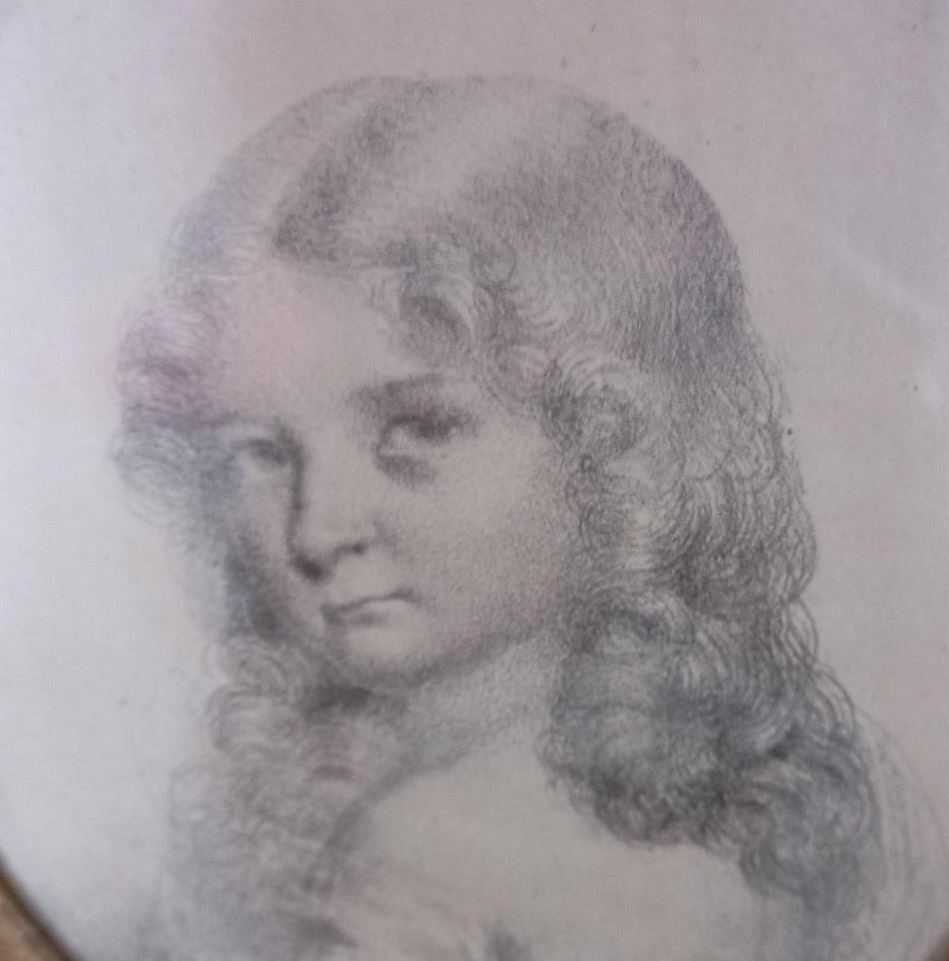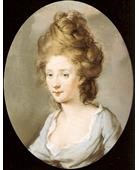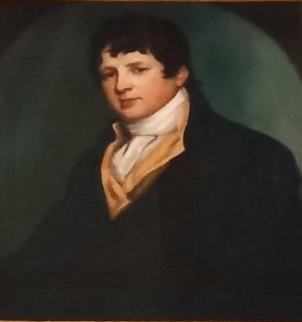The Library
The interior decoration is a faithful recreation of the furnishing style of the mid to late 19th century.
Thanks to a salvaged fabric remnant found behind a skirting board , it was possible to commission the French silk poplin on the walls in its original pattern and colour from the firm of Prelle in Lyons in France.
The claret silk damask curtains are also based on the originals were made in Ireland.
One of the nine massive curtain pelmets is original and an Irish firm of Master Gilders faithfully reproduced matching gilt reproductions.
The bookcases were also reproduced based on one original bookcase acquired by the OPW in the 1980s, this original with its 19th century glass stands in the right end corner of the library.
The matching pair of pier mirrors over the mantelpieces was conserved and re gilded.
Highlights
Georgian folding table
An intricately inlayed walnut table in the Georgian breakfast style.
The Georgian period saw an increase in formality in dining and furniture design becomes ever more elaborate and status defining.
This table is thought to date from c.1800 at the time of the Act of union with the emblems of Ireland (shamrock), Scotland (thistle) and England (rose) displayed within the decoration.
Zogroscope
A Pillar Zogroscope or Optical device was popular during the latter half of the 18th century as parlour amusements.
The zogroscope was designed to magnify prints so they could be seen more easily with enhanced depth.
It has a convex lens mounted in a square wooden frame that, in turn, is supported on a pedestal.
A second frame, hinged at the top, holds a mirror that can be held out at any desired angle.
The form came into use in the eighteenth century and remained popular throughout the nineteenth century.
It was also known as an optical diagonal machine or cosmorama.
Cellarette
Victorian rectangular cellarette with compartments for holding decanters. This cellarette is raised on turned supports and brass castors.
A cellarette was a movable cabinet designed to hold liquors and wine, used from the 18th century onwards.
It was usually kept under the centre of a sideboard and rolled out for use.
As wine was a luxury item some cellarettes had a lock and could be elaborately decorated.
It was around the mid 18th century lead lining was introduced to keep the bottles as cool as possible.
Prior to a meal, wine bottles would be transferred from the cellar to the cellarette.
It would sit under the sideboard pedestal and during the meal the bottle would be retrieved to serve the wine (chilled) to the guests.
Originally cellarettes would have been designed as part of a sideboard/dining suite, but later became less popular and eventually redundant as built in cellaret drawers in sideboards became more in vogue in the Victorian period.
Berber style rug
Berber style rugs were designed and woven for this room by the firm of Woodward Grosvenor in the 1990’s.
The restoration team were fortunate in finding the original receipt for the carpet in the family papers, and were able to trace the original company who had retained the design records.
The design is based on patterns adapted from Izmir motifs.
The Woodward Grosvenor company was based in Kidderminster, England.
The town has been a centre of weaving for many centuries, and in the mid – late 18th century began to specialize in new forms of carpet weaving, earning the title of Carpet Capital of Britain.
The company was founded in 1790 by Henry Woodward.
in 1855 with his partner Benjamin Grosvenor, he build the Stour valley Mill, the first steam-powered carpet mill in Britain.
Pole screens
A pair of mahogany and needlepoint pole screens.
Pole screens became popular from the 1740s and often, as here, carried panels of embroidery, which might be the work of women at home, mounted and set up in a frame by a cabinet-maker.
The adjustable screens allowed women to sit close to the fire for warmth, while protecting their faces from the heat of the fire.
Display case
The display case contains relics of Walter Butler, de jure 16th Earl of Ormonde & Eleanor Morres youngest daughter Lady Eleanor Butler.
Lady Eleanor Butler (1739–1829) and her companion Sarah Ponsonby (1755–1831) secretly fled to Wales in 1778.
Lady Eleanor and Sarah were known popularly as the Ladies of Llangollen and lived in a cottage Orné “Plâs Newydd” in Llangollen, Wales for over 50 years.
The paintings
Bellingham Boyle (1709-1771), unknown artist
Bellingham Boyle (1709-1771)
Artist: Unknown
From the Langrishe Collection.
Half-length full face portrait of a gentleman in dark green/olive jacket, floral-patterned waistcoat and white shirt.
Set against a dark brown background.
His daughter married Sir Robt Langrishe 2nd Bt.
Portrait of a Young Lady in blue dress by Stephen Slaughter (d.1765)
Portrait of a Young Lady in blue dress
Artist: Stephen Slaughter (d.1765)
The sitter is depicted wearing a blue wrap dress, with a basket of flowers in her left hand, her right hand reaching towards some orange blossom.
Catherine Vigors (1794-1820) by Robert Lawrence (1794-1820)
Catherine Vigors (1794-1820)
Artist: Robert Lawrence (1794-1820)
Catherine was the daughter of Soloman Richards of Solborough, Co Wexford.
She married Nicholas Aylward Vigors of Old Leighlin and Belmont, Co Carlow, in 1781.
The sitter is depicted wearing a white dress, blue wrap and pearls.
Unknown man, possibly Mr M Shee, unknown artist
Unknown man, possibly Mr M Shee
Artist: unknown
Half-length portrait, said to be of Mr Martin Shee (d.1783), father of the artist Sir Martin Archer Shee P.R.A.
The costume details would indicate a date of c. 1815.
Shee’s father was known to be blind, and it is noticeable that the eyes in this portrait are unfocused.
Catherine Morres (d.1851) by John Comerford (1773-1835)
Catherine Morres (d.1851)
1st Viscountess Frankfort de Montmorency.
Artist: John Comerford (1773-1835)
Catherine Morres was the second wife of the Viscount Frankfort de Montmorency, and daughter of George White of Castlebellingham.
The family of Morres changed their name to de Montmorency in 1815, claiming descent from the Norman Geoffry de Marisco.
The claim has been dismissed in the following terms: ‘This cock and bull pedigree or genealogical nightmare, which for sheer topsy-turveydom, has, I venture to assert, never been surpassed.’
The sitter is wearing a large muslin bonnet of a type which was fashionable and worn by married ladies during the early years of the nineteenth century.
Portrait of unknown lady, possibly member of Shee Family, Irish school.
Portrait of unknown lady, possibly member of Shee Family
Artist: Irish school, eighteenth century
Half length portrait of unknown lady. Deep v. neck blue/green shift (wrap dress)
Grace Louisa Staples (1779-1860) by John Comerford (1773-1835)
Grace Louisa Staples (1779-1860)
Marchioness of Ormonde
Artist: John Comerford (1773-1835)
Daughter of the Rt Hon John Staples of Lissan, near Dungannon, and Henrietta, fourth daughter of Richard, 3rd Viscount Molesworth, she married James Butler, 19th earl and 1st Marquess of Ormonde, in 1807.
This small, half-length portrait is a variation on the full-length portrait of the sitter by John Saunders displayed in the Picture Gallery.
Costume details are similar to those of the large-scale portrait.
Hon Louisa Anne Molesworth (1749-1824) by Hugh Douglas Hamilton (ca.1739-1808)
Hon Louisa Anne Molesworth (1749-1824)
Lady Ponsoby, and later Countess Fitzwilliam
Artist: Hugh Douglas Hamilton (ca.1739-1808)
The fourth daughter of the 3rd Viscount Molesworth and his second wife Mary Ushe, she married William Brabazon (later Baron) Ponsoby of Imokillly, Co. Cork, in 1769.
Secondly, in 1823, she married Earl Fitzwilliam when he was 75 and she 73.
She was a sister of Hon. Henrietta Molesworth.
The sitter is wearing a carefully arranged cap on her elaborate coiffure.
This is a fine example of Hamilton’s most popular form – the small oval portrait.
Pastel portraits of this type are liable to be damaged by light or wear, and it is unusual to find one in such good condition.
Anastasie de Crussol, unknown artist
Anastasie de Crussol
Artist: unknown
Inscribed on the back:”Anastasie de Crussol, daughter to the dear friend of Mary Countess of Harcourt who lived during the time of the Emigration of the French principally at St Leonards, she died soon after the birth of her daughter.
Her mother was daughter to the Duc de Montilmar”.
Charles Robert Moore (1848-1869), unknown artist
Charles Robert Moore (1848-1869)
Artist: unknown
Inscribed on the back: “My beloved uncle [as a] child Charles Robt Moore he died at Alexandria aged 21 in 1869.
The sitter is depicted wearing a blue dress.
He has short red hair.
James Butler (1774-1838) by John Comerford (1773-1835)
James Butler (1774-1838)
1st Marquess of Ormonde, 19th Earl of Ormonde
Artist: John Comerford (1773-1835)
This small, half-length portrait is a variation on the full-length portrait of the sitter by John Saunders displayed in the Picture Gallery.
Costume details are similar to those of the large-scale portrait, but here the artist has inserted a plinth in the foreground.
There is a red drape and a classical column in the background.
An engraving by Charles Parker is close to this portrait, although the image has not been reversed.
Hon Henrietta Molesworth (d. 1813) by Hugh Douglas Hamilton (1740-1808)
Hon Henrietta Molesworth (d. 1813)
Mrs Staples
Artist: Hugh Douglas Hamilton (1740-1808)
Eldest daughter of the 3rd Viscount Molesworth and his second wife Mary Usher, she married the Rt Hon John Staples of Lissan, Co Tyrone, in 1774.
Their daughter, Grace Louisa Staples married James Butler, 19th Earl and 1st Marquis of Ormonde.
She was a sister of Hon Louisa Anne Molesworth.
The sitter’s hair is piled high in the fashionable manner of the time.
This is another well-preserved example of Hamilton’s pastel technique.
Pastel portraits of this type are liable to be damaged by light or wear, and it is unusual to find one in such good condition.
Mrs Ross, attributed to Adam Buck (1759-1833)
Mrs Ross
Artist: attributed to Adam Buck (1759-1833)
Isabella Barbara Evelyn was the daughter of Sir Gunning Bart and Ann Sutton. She married General Alexander Ross (1742-1827) in 1795
Inscribed on back: “Mrs Ross intimate friend of Mary Countess of Harcourt she was daughter of Sr. Robt. Gunning Bart., and wife of General Ross”
Her garment has a very high frill at the neck. She wears a striped turban and has short curly hair.
Lady Flora Hastings (1806-1839), attributed to Adam Buck (1759-1833)
Lady Flora Hastings (1806-1839)
Artist: attributed to Adam Buck (1759-1833)
Lady Flora Elizabeth Hastings was the eldest child of Francis Rawdon Hastings, 1st Marquess of Hastings and Flora Mure Campbell, Countess of Loudown.
In 1834 the unmarried Flora was appointed lady-in-waiting to future Queen Victoria’s mother, the Duchess of Kent.
She was the innocent centre of a scandal that rocked court and government and caused Victoria’s popularity to plummet.
The sitter is wearing a white low cut empire line dress, with curls and ringlets in her hair.
Unknown sitter, said to be George Eyton Parry, English school,
Unknown sitter, said to be George Eyton Parry
Artist: English school, seventeenth century
Half-length portrait, the sitter is dressed in brown with a wine wrap around his shoulders, His distorted left hand is due to paint loss and damage.
Unknown Lady, English school
Unknown Lady
Artist: English school, C.1710
The sitter is wearing a brown dress.
She is in a painted oval.
Elizabeth Jones (1665-1758), after William Wissing
Elizabeth Jones (1665-1758)
Countess of Kildare
Artist: after William Wissing
Wife of John Fitzgerald, 18th Earl of Kildare, and daughter of the 1st Earl of Ranelagh, Lady Elizabeth was an heiress with a fortune of £10,000 when she married in 1684.
She was buried in Westmisnster Abbey.
The sitter wears a blue dress with white sleeves and frills and a brown shawl over her head.
She wears no pearls.
There is an inscription on the right middle-ground of the painting – ‘The Countess of Kildare Eldest Daughter to ye Earl of Ranelagh & sister to the Lady Coningesby’.
James Butler (1774-1838), unknown artist
James Butler (1774-1838)
1st Marquess of Ormonde, 19th Earl of Ormonde
Artist: unknown
James Butler was born at Kilkenny Castle the 15th July 1774, third son of john Butler, 17th Earl of Ormonde and Lady Frances Susannah Anne Wandesforde.
He was educated at Eton and succeeded his brother Walter as Earl of Ormonde in 1820 becoming one of the largest landowners of Ireland.
He and his younger brother Charles Harward were friends of the Prince of Wales.
He married Grace Louisa Staples in 1807.
Rachel Russell (1624-1725) [possibly] Formerly called the Duchess of Ormonde, in the style of Michael Dahl
Rachel Russell (1624-1725) [possibly] Formerly called the Duchess of Ormonde
in the style of Michael Dahl
Rachel Russell was the wife of William, 2nd Duke of Devonshire.
Rachel was related by marriage to the Ormonde family, her husband was the son of Mary Butler, 1st Duchess of Devonshire.
This portrait bears a resemblance to other portraits of Rachel Russel, Duchess of Devonshire
Unknown lady, attributed to John Lewis (fl.1740-69)
Unknown lady
Artist: attributed to John Lewis (fl.1740-69)
The sitter is wearing a pink dress with pearl buttons.

